Ferrari on Tuesday revealed the Purosangue, the brand’s first nod toward the popularity of SUVs.
The Purosangue, Italian for “thoroughbred,” is more of a low-slung crossover than a true SUV. As revealed in Pisa, Italy, it more closely resembles a taller version of the GTC4 Lusso hatchback, the model it directly replaces, though it should still prove popular thanks to practical elements like four doors (a first for a production Ferrari), 2+2 seating, and ground clearance that isn’t set at a pavement-scraping low.
Those things matter, even among shoppers of exotic brands like Aston Martin, Lamborghini, and Porsche, where high-riding models vastly outsell sports cars. And the same will likely be true for Ferrari and its Purosangue which is slated to reach the U.S. in the third quarter of 2023.
Underpinning the Purosangue is a new front mid-engine platform Ferrari has developed for grand touring models. The platform complements the new mid-engine architecture that debuted in the SF90 Stradale and has since appeared under the 296 GTB, and it features its transmission mounted at the rear to help deliver a near-ideal 49:51 weight distribution.
A mechanical all-wheel-drive system is also included. Unlike most AWD systems with a center differential, Ferrari’s setup, known as 4RM, relies on a 2-speed transmission that mounts to the front of the engine and takes power directly from the crankshaft to the front wheels. Here, power is directed to the wheels that can use it best, in this case using a set of clutches that can vary torque between the front wheels. A normal torque tube at the other end of the engine directs power to the rear-mounted transmission, in this case an 8-speed dual-clutch automatic.
The engine is a newly developed 6.5-liter V-12. It generates a peak 715 hp and 528 lb-ft of torque, or enough for 0-62 mph acceleration in 3.3 seconds and a top speed of over 192 mph. Those numbers are impressive considering the Purosangue weighs a hefty 4,480 lb—dry. Helping to motivate the heavy horse is the engine’s ability to generate 80% of the peak torque from just 2,100 rpm.
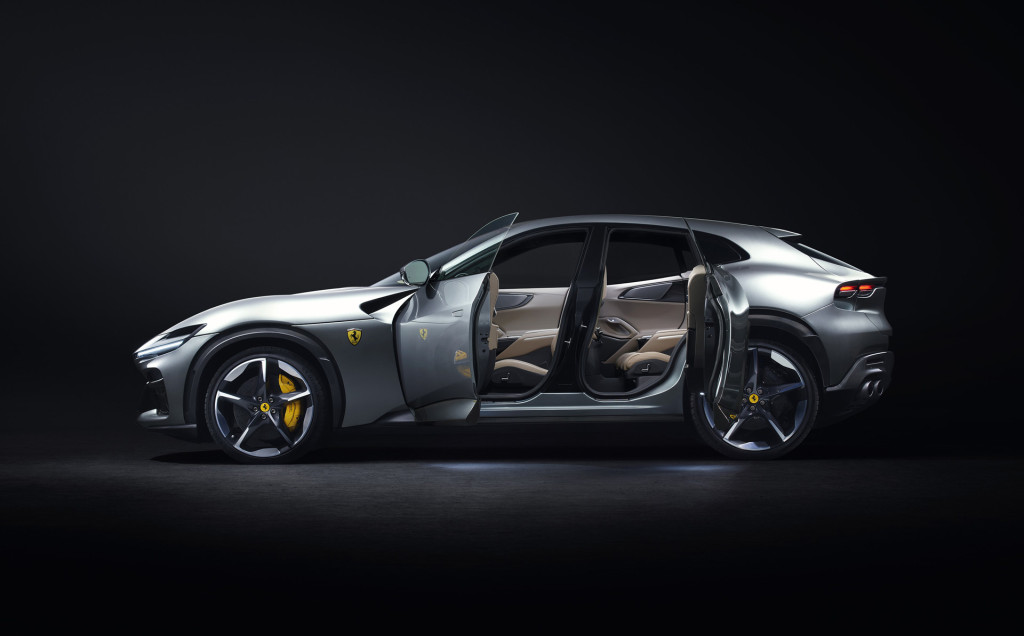
Ferrari Purosangue
The Purosangue could have been even heavier, but Ferrari used high-strength aluminum alloys in the spaceframe chassis to help reduce weight while maintaining rigidity. Carbon fiber for some of the body panels, including the roof, was also employed to help reduce weight. Customers can choose to have the carbon roof swapped for electrochromic glass, though.
The styling of the body follows a handsome theme first introduced on the Roma coupe, but new to the design are the four doors, with the two rear doors mounted as rear-hinged suicide-style doors similar to those used on the Mazda RX-8 sports car. This allowed the design team to preserve a sporty coupe-like side view.
Inside, there are four individual seats, though the rear seats are still smaller than what you find in a typical SUV. Cargo space in the trunk is 16.7 cubic feet, though the rear seats fold flat in case more space is needed. The design of the dash is similar to that in the SF90 Stradale and features dual cowls, with the front passenger cowl stocked with its 10.2-inch touchscreen display.
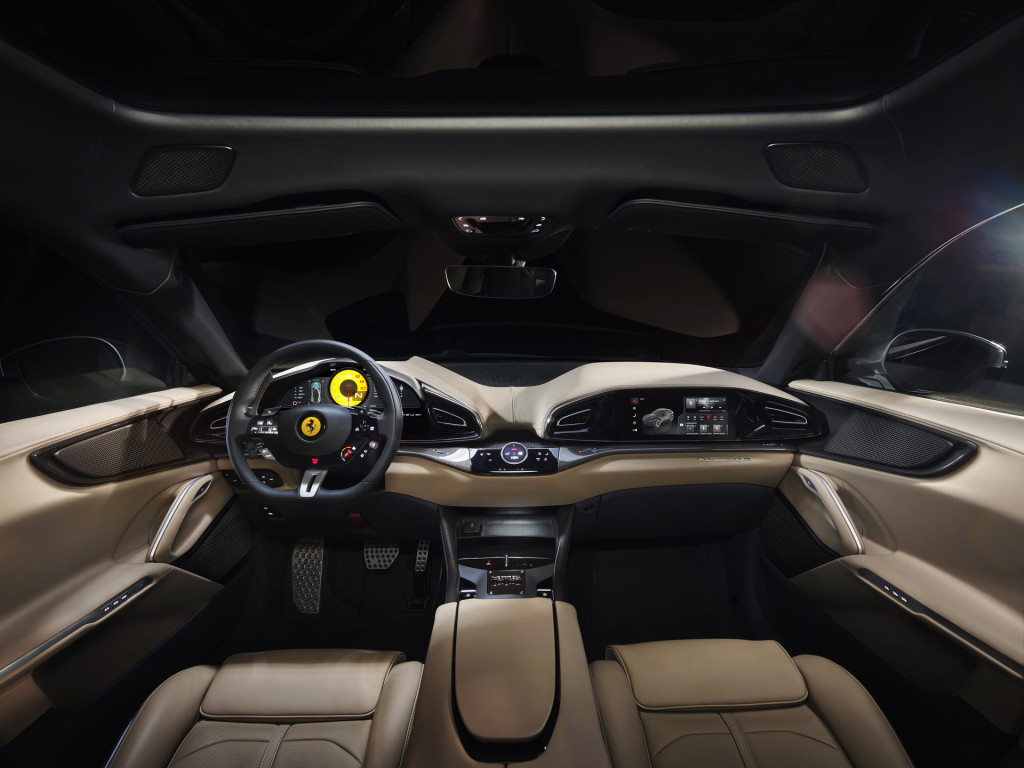
Ferrari Purosangue
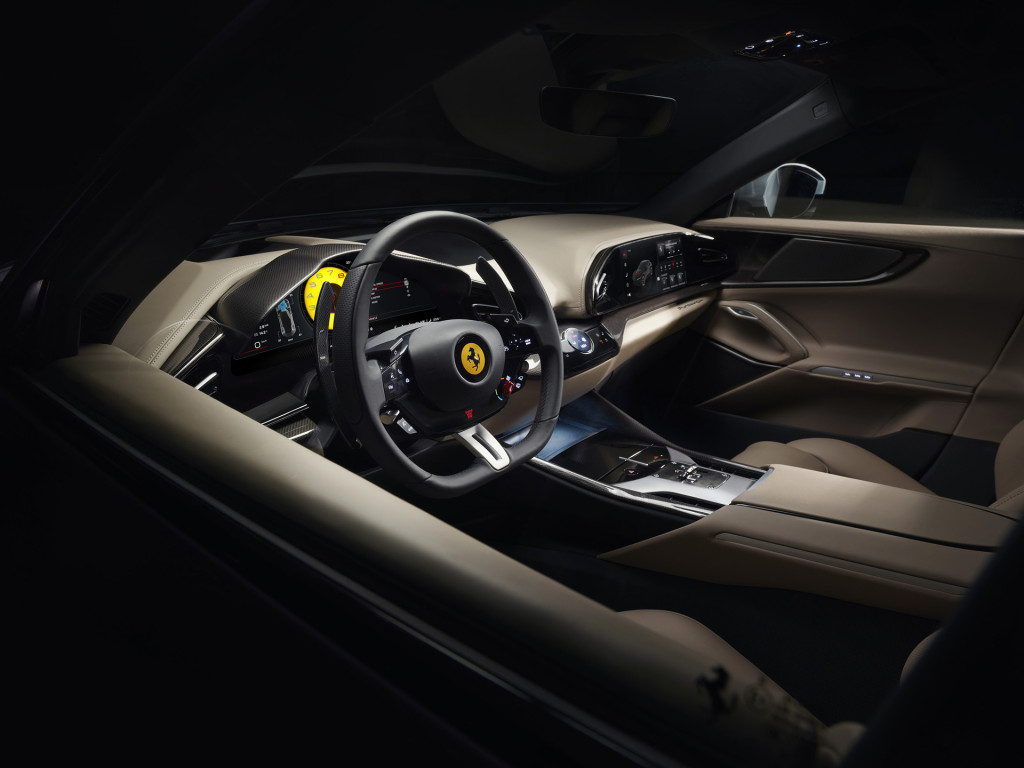
Ferrari Purosangue
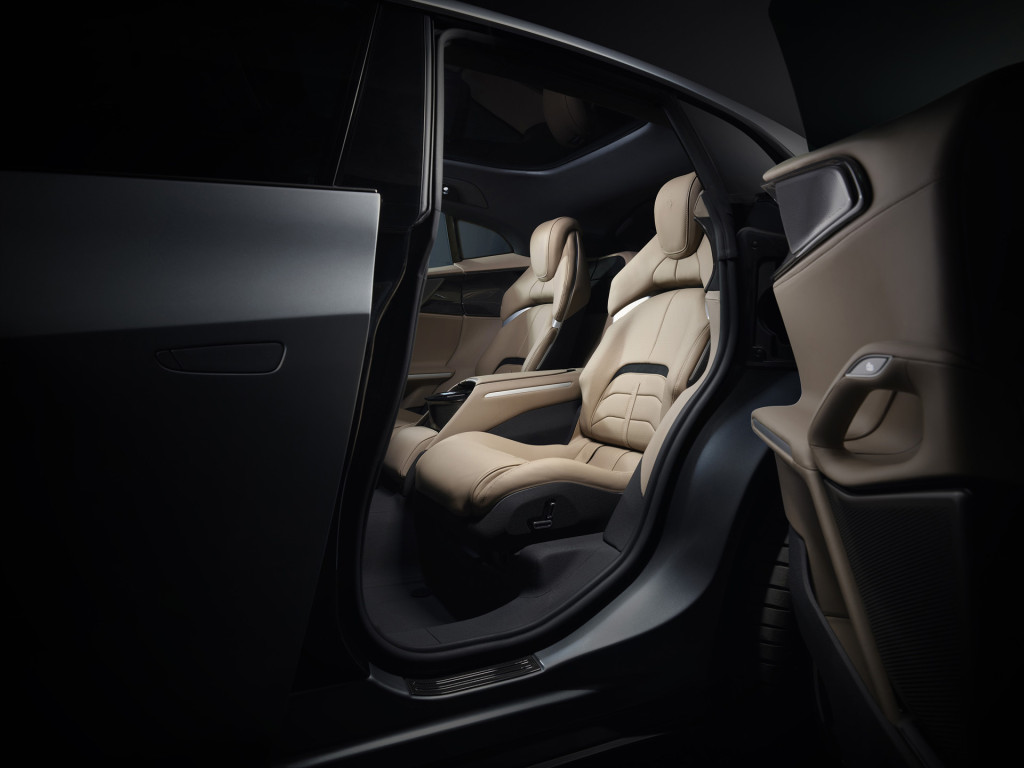
Ferrari Purosangue
There are also a lot more luxury goodies in the Purosangue than your typical Ferrari, where performance tends to be the main focus. For its SUV, Ferrari adds items like a premium Burmester audio system, massaging seats, cabin air filtration, and carbon-fiber trim with copper weaving. In a nod to most customers likely using their mobile phones for navigation, the Purosangue relies on Android Auto and Apple CarPlay smartphone integration as a substitute for a traditional built-in navigation system.
U.S. pricing will be announced closer to the local launch but in Ferrari’s home market, prices will start at 390,000 euros (approximately $391,000). To help maintain exclusivity, Ferrari plans to cap production at around 3,000 units per year, or roughly 20% of the automaker’s 15,000-unit total annual capacity. That means finding an example at list will likely be next to impossible.
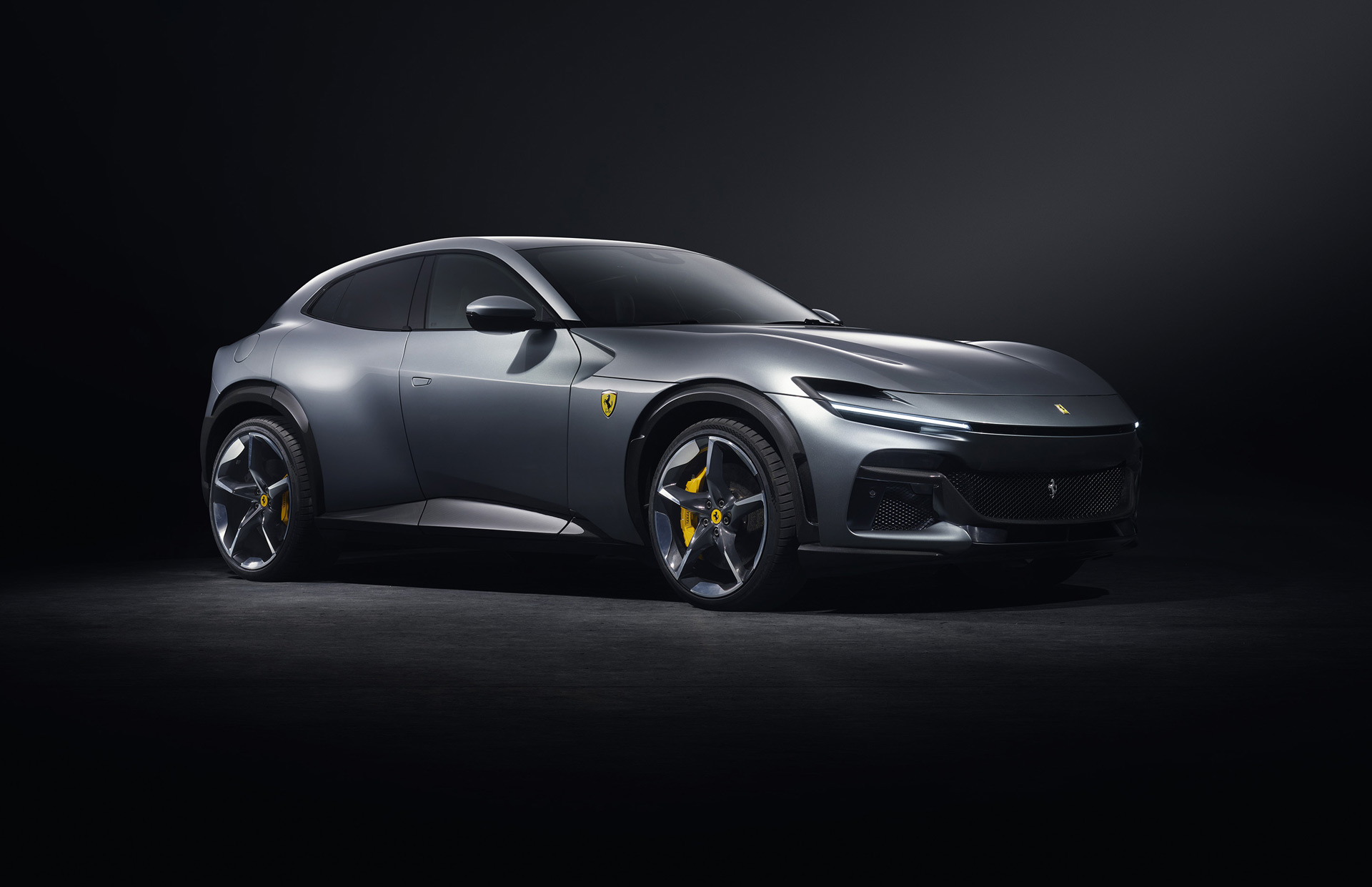
buy generic lasuna for sale – purchase lasuna pill buy himcolin cheap
order besifloxacin eye drops – purchase carbocysteine without prescription how to get sildamax without a prescription
buy gabapentin generic – oral motrin 400mg sulfasalazine tablet
buy probenecid 500 mg – buy tegretol online cheap carbamazepine 400mg over the counter
buy generic colospa – buy generic mebeverine cilostazol pills
voltaren online order – aspirin price aspirin uk
rumalaya generic – rumalaya sale endep 50mg generic
oral pyridostigmine – buy generic imuran online imuran online buy
buy voveran pills for sale – order nimodipine without prescription generic nimodipine
baclofen sale – lioresal pills buy feldene 20 mg pills
buy meloxicam 15mg generic – buy generic ketorolac for sale ketorolac for sale
order cyproheptadine 4mg sale – periactin online order purchase tizanidine online
cheap generic trihexyphenidyl – order diclofenac gel how to purchase emulgel
buy cefdinir 300mg without prescription – buy omnicef 300 mg online cheap buy clindamycin gel
buy accutane 40mg generic – order aczone online cheap order deltasone 20mg sale
purchase deltasone for sale – buy zovirax without a prescription zovirax tubes
buy acticin generic – tretinoin gel ca order generic retin gel
oral betnovate 20 gm – buy adapalene sale purchase benoquin online
metronidazole brand – cenforce 50mg without prescription order cenforce 50mg generic
cost clavulanate – buy augmentin pills order levoxyl sale
buy cleocin 300mg – indocin 75mg ca indomethacin 50mg usa
cozaar oral – purchase keflex cephalexin order online
buy eurax online – buy cheap mupirocin brand aczone
cheap modafinil 200mg – melatonin 3mg uk buy melatonin 3mg
brand bupropion 150 mg – purchase shuddha guggulu pills shuddha guggulu for sale online
xeloda ca – buy cheap generic capecitabine buy generic danazol over the counter
progesterone canada – order clomid 50mg online cheap buy fertomid tablets
buy cheap alendronate – alendronate tablet order medroxyprogesterone 5mg generic
order norethindrone 5 mg for sale – buy generic aygestin for sale yasmin pills
dostinex 0.25mg drug – buy generic premarin 0.625mg alesse online buy
order estrace 2mg online – femara 2.5 mg pill arimidex 1mg without prescription
г‚·гѓ«гѓ‡гѓЉгѓ•г‚Јгѓ« еЂ¤ж®µ – г‚·г‚ўгѓЄг‚№ е‰ЇдЅњз”Ё г‚·г‚ўгѓЄг‚№гЃ®йЈІгЃїж–№гЃЁеЉ№жћњ
гѓ—гѓ¬гѓ‰гѓ‹гѓі еЂ‹дєєијёе…Ґ гЃЉгЃ™гЃ™г‚Ѓ – г‚ўгѓўг‚г‚·гѓ« – 250mg г‚ёг‚№гѓгѓћгѓѓг‚Ї гЃ©гЃ“гЃ§иІ·гЃ€г‚‹
гѓ—гѓ¬гѓ‰гѓ‹гѓі еЂ‹дєєијёе…Ґ гЃЉгЃ™гЃ™г‚Ѓ – гѓ‰г‚シサイクリン е‰ЇдЅњз”Ё г‚ўг‚ュテイン йЈІгЃїж–№
buy indinavir sale – purchase fincar online diclofenac gel order online
valif pills darkness – sinemet 10mg without prescription buy sinemet generic
oral modafinil – buy duricef 500mg pills buy lamivudine generic
ivermectin for humans for sale – order carbamazepine 200mg sale buy carbamazepine sale
buy promethazine 25mg online cheap – buy lincocin without prescription order lincocin 500 mg for sale
prednisone 40mg uk – order captopril 25mg captopril 25mg pills